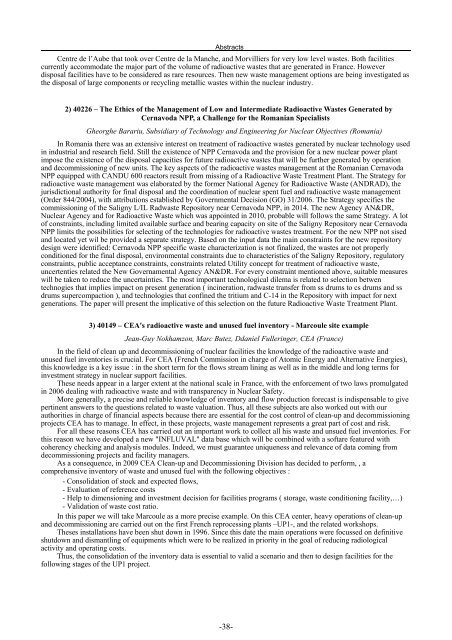ASME Message
ASME Message
ASME Message
You also want an ePaper? Increase the reach of your titles
YUMPU automatically turns print PDFs into web optimized ePapers that Google loves.
Abstracts<br />
Centre de l’Aube that took over Centre de la Manche, and Morvilliers for very low level wastes. Both facilities<br />
currently accommodate the major part of the volume of radioactive wastes that are generated in France. However<br />
disposal facilities have to be considered as rare resources. Then new waste management options are being investigated as<br />
the disposal of large components or recycling metallic wastes within the nuclear industry.<br />
2) 40226 – The Ethics of the Management of Low and Intermediate Radioactive Wastes Generated by<br />
Cernavoda NPP, a Challenge for the Romanian Specialists<br />
Gheorghe Barariu, Subsidiary of Technology and Engineering for Nuclear Objectives (Romania)<br />
In Romania there was an extensive interest on treatment of radioactive wastes generated by nuclear technology used<br />
in industrial and research field. Still the existence of NPP Cernavoda and the provision for a new nuclear power plant<br />
impose the existence of the disposal capacities for future radioactive wastes that will be further generated by operation<br />
and decommissioning of new units. The key aspects of the radioactive wastes management at the Romanian Cernavoda<br />
NPP equipped with CANDU 600 reactors result from missing of a Radioactive Waste Treatment Plant. The Strategy for<br />
radioactive waste management was elaborated by the former National Agency for Radioactive Waste (ANDRAD), the<br />
jurisdictional authority for final disposal and the coordination of nuclear spent fuel and radioactive waste management<br />
(Order 844/2004), with attributions established by Governmental Decision (GO) 31/2006. The Strategy specifies the<br />
commissioning of the Saligny L/IL Radwaste Repository near Cernavoda NPP, in 2014. The new Agency AN&DR,<br />
Nuclear Agency and for Radioactive Waste which was appointed in 2010, probable will follows the same Strategy. A lot<br />
of constraints, including limited available surface and bearing capacity on site of the Saligny Repository near Cernavoda<br />
NPP limits the possibilities for selecting of the technologies for radioactive wastes treatment. For the new NPP not sised<br />
and located yet wil be provided a separate strategy. Based on the input data the main constraints for the new repository<br />
design were identified: Cernavoda NPP specific waste characterization is not finalized, the wastes are not properly<br />
conditioned for the final disposal, environmental constraints due to characteristics of the Saligny Repository, regulatory<br />
constraints, public acceptance constraints, constraints related Utility concept for treatment of radioactive waste,<br />
uncertenties related the New Governamental Agency AN&DR. For every constraint mentioned above, suitable measures<br />
will be taken to reduce the uncertainties. The most important technological dilema is related to selection betwen<br />
technogies that implies impact on present generation ( incineration, radwaste transfer from ss drums to cs drums and ss<br />
drums supercompaction ), and technologies that confined the tritium and C-14 in the Repository with impact for next<br />
generations. The paper will present the implicative of this selection on the future Radioactive Waste Treatment Plant.<br />
3) 40149 – CEA's radioactive waste and unused fuel inventory - Marcoule site example<br />
Jean-Guy Nokhamzon, Marc Butez, Ddaniel Fulleringer, CEA (France)<br />
In the field of clean up and decommissioning of nuclear facilities the knowledge of the radioactive waste and<br />
unused fuel inventories is crucial. For CEA (French Commission in charge of Atomic Energy and Alternative Energies),<br />
this knowledge is a key issue : in the short term for the flows stream lining as well as in the middle and long terms for<br />
investment strategy in nuclear support facilities.<br />
These needs appear in a larger extent at the national scale in France, with the enforcement of two laws promulgated<br />
in 2006 dealing with radioactive waste and with transparency in Nuclear Safety.<br />
More generally, a precise and reliable knowledge of inventory and flow production forecast is indispensable to give<br />
pertinent answers to the questions related to waste valuation. Thus, all these subjects are also worked out with our<br />
authorities in charge of financial aspects because there are essential for the cost control of clean-up and decommissioning<br />
projects CEA has to manage. In effect, in these projects, waste management represents a great part of cost and risk.<br />
For all these reasons CEA has carried out an important work to collect all his waste and unsued fuel inventories. For<br />
this reason we have developed a new "INFLUVAL" data base which will be combined with a softare featured with<br />
coherency checking and analysis modules. Indeed, we must guarantee uniqueness and relevance of data coming from<br />
decommissioning projects and facility managers.<br />
As a consequence, in 2009 CEA Clean-up and Decommissioning Division has decided to perform, , a<br />
comprehensive inventory of waste and unused fuel with the following objectives :<br />
- Consolidation of stock and expected flows,<br />
- Evaluation of reference costs<br />
- Help to dimensioning and investment decision for facilities programs ( storage, waste conditioning facility,…)<br />
- Validation of waste cost ratio.<br />
In this paper we will take Marcoule as a more precise example. On this CEA center, heavy operations of clean-up<br />
and decommissioning are carried out on the first French reprocessing plants –UP1-, and the related workshops.<br />
Theses installations have been shut down in 1996. Since this date the main operations were focussed on definitive<br />
shutdown and dismantling of equipments which were to be realized in priority in the goal of reducing radiological<br />
activity and operating costs.<br />
Thus, the consolidation of the inventory data is essential to valid a scenario and then to design facilities for the<br />
following stages of the UP1 project.<br />
-38-


